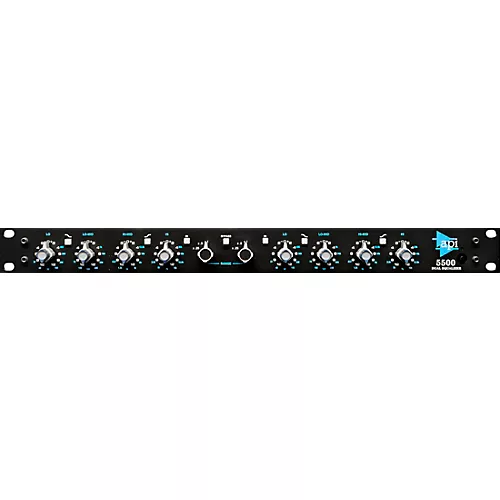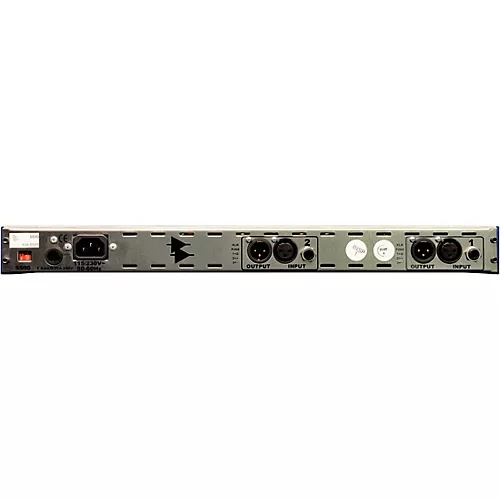API 5500 Stereo/Dual Mono 550 EQs With Range Switch
Quantity
-
DetailThe beginnings of the 5500 circuit can be traced back to the original 550 equalizer designed by Saul Walker, the founder of Automated Processes Inc. The 550 was designed as a console equalizer, which uses an unbalanced input due to the architecture of the recording console. Because the ergonomics of a console dictate that the controls take up little space, sometimes the number of included functions can be limited. The 5500 is specifically designed to address these limitations; it has a balanced input, a true straight-wire bypass, an integrated power supply with noiseless muting and a range control that expands its versatility to mastering applications.Typical of API products, the 5500 contains no integrated circuits in its signal path. The gain comes from two hand-built 2520 Operational Amplifiers in each channel. The balanced input is handled by a 2510 Discrete Operational Amplifier, which is similar to the 2520, but without the high-current output stage. A key component of the API sound, the 2520 coupled with the API 2503 output transformer, is capable of delivering +30dBm before clipping.An extremely useful feature in the 5500 is the range control. The range of the amplitude controls can be reduced to 1/2 or 1/4 of their stated scale, providing a means to adjust the tonal balance with finer resolution in an even gentler manner. This is especially useful for complex program material as contained in stems or submixes and is ideally suited for mastering purposes.API's 5500 also features a true hard-wire bypass which wires the output connector directly to the input. Shortly after the power is first applied, or immediately after it is lost, a special circuit enables "bypass mode" so that power thumps are never heard.The 5500's input XLR is connected to an active balanced circuit. The unit's output XLR is driven from a transformer coupled output and can drive any load from 600 ohms or more to full output capability. There is no change from input to output in the unit's polarity, so it is suitable in studios using either pin 2 or pin 3 as the "hot" connection. Additionally, the 5500 has a 1/4 inch input connector that interrupts any present signal on the input XLR. It is balanced and can be driven from either balanced or unbalanced sources. A positive signal on the tip will deliver a positive signal on pin 2 of the output XLR. Using the 1/4 inch input does not bypass any internal circuitry and does not change the gain or operating levels.The 5500 features API's industry exclusive five-year parts warranty and exhibits the reliability and long life characteristic of all API products.
-
Customer ReviewsNo comments

 Fender
Fender Gibson
Gibson Taylor
Taylor Martin
Martin lbanez
lbanez Epiphone
Epiphone PRS
PRS Schecter Guitar Research
Schecter Guitar Research Fender Stratocaster
Fender Stratocaster Fender Telecaster
Fender Telecaster Gibson Les Paul
Gibson Les Paul Gibson SG
Gibson SG lbanez RG
lbanez RG Taylor American Dream
Taylor American Dream Taylor GS Mini
Taylor GS Mini Martin GPC
Martin GPC lbanez
lbanez Fender
Fender Squier
Squier Ernie Ball Music Man
Ernie Ball Music Man Sterling by Music Man
Sterling by Music Man Rickenbacker
Rickenbacker Sire
Sire Schecter Guitar Research
Schecter Guitar Research Fender Precision Bass
Fender Precision Bass Fender Jazz Bass
Fender Jazz Bass Fender Mustang
Fender Mustang lbanez SR
lbanez SR Strandberg Boden
Strandberg Boden Yamaha TRBX
Yamaha TRBX Yamaha BB
Yamaha BB Schecter Stiletto
Schecter Stiletto Fender
Fender Marshall
Marshall Orange Amplifiers
Orange Amplifiers Markbass
Markbass Boss
Boss Blackstar
Blackstar Kemper
Kemper Vox
Vox Line 6
Line 6 Electro-Harmonix
Electro-Harmonix MXR
MXR Meris
Meris Dunlop
Dunlop EarthQuaker Devices
EarthQuaker Devices lbanez
lbanez TC Electronic
TC Electronic Alesis
Alesis Roland
Roland Zildjian
Zildjian DW
DW Simmons
Simmons Meinl
Meinl Remo
Remo TAMA
TAMA Pearl
Pearl Vic Firth
Vic Firth Sound Percussion Labs
Sound Percussion Labs Evans
Evans Sabian
Sabian Lp
Lp Yamaha
Yamaha Yamaha
Yamaha Roland
Roland Korg
Korg Williams
Williams Akai Professiona
Akai Professiona Casio
Casio Nord
Nord Moog
Moog Williams Legato
Williams Legato Yamaha Clavinova
Yamaha Clavinova Harbinger
Harbinger Bose
Bose JBL
JBL Electro-Voice
Electro-Voice Behringer
Behringer Yamaha
Yamaha Mackie
Mackie JBL EON
JBL EON Bose L1 Pro
Bose L1 Pro QSC K Series
QSC K Series Yamaha Mixers
Yamaha Mixers Harbinger VAR!
Harbinger VAR! Focusrite
Focusrite Universal Audio
Universal Audio Yamaha
Yamaha PreSonus
PreSonus Tascam
Tascam KRK
KRK Rode
Rode Focusrite Scarlett
Focusrite Scarlett Universal Audio Apollo
Universal Audio Apollo Shure
Shure Sennheiser
Sennheiser AKG
AKG Neumann
Neumann Rode
Rode Sterling Audio
Sterling Audio Audio-Technica
Audio-Technica Warm Audio
Warm Audio AKG 414
AKG 414 Musician Geal
Musician Geal Fender
Fender D'Addario
D'Addario Ernie Ball
Ernie Ball Elixir
Elixir Road Runner
Road Runner Gator
Gator Proline
Proline Remo
Remo Livewire
Livewire On-Stage
On-Stage Hercules
Hercules Mogami
Mogami Dunlop
Dunlop Perri's
Perri's Snark
Snark

